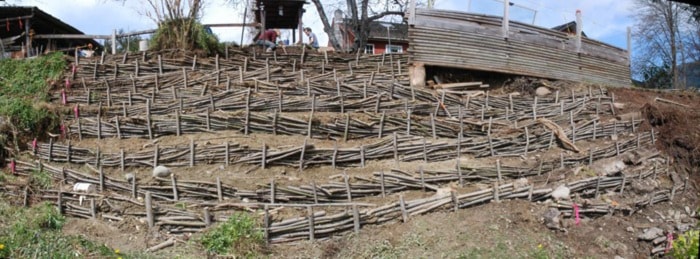A couple of weeks ago, Lois Atchison woke up and noticed that her back yard was a lot brighter than usual. It took her a moment to realize that the maple that once stood tall on the small stretch of Cowichan River that borders the back of her property, was gone. That bank had suddenly fallen into the Cowichan River, taking the tree with it.
Instead of reinforcing the bank in with riprap (rock or other material used to protect shorelines from erosion) manner, she contacted Gerald Thom, chair of the Cowichan Lake and River Stewardship Society. Thom, besides being actively involved in the stewardship of the Lake Cowichan area, had taken a bioengineering course taught by Dave Polster, a plant ecologist and owner of Polster Environmental Services Ltd. After looking at the collapsed embankment, Thom decided that Atchison should talk to Polster.
For the past 35 years, Polster has worked on land reclamation and erosion control projects. He says he uses living plants to keep soil erosion in check. For projects like the collapsed bank at Atchison’s, he and his crew, Chris Adams (owner of Adams Environmental Services), Mark Mitchell, and Emily Morin, built up tiered retaining walls from the top of the slope downwards. For the embankment at Atchison’s, they have taken hundreds of willow cuttings from Gordon River Camp, and have driven stakes made from these willow cuttings into the embankment. They then wove other, longer cuttings between the stakes. The result is a kind of tiered fence structure, behind which they filled with soil pulled from the upper part of the bank and the surrounding embankment. Polster says that in a month or so, the cuttings will have buds and sprouts on them, and that by the end of summer they will have shoots reaching about a metre tall.
Polster says that soil erosion problems occur for two reasons: fill from a housing construction site being dumped to create an embankment, and the invasive species that take over, replacing the trees whose roots had held the bank in place. Willow root is known for having stronger roots than other tree species, including spruce and douglas fir, but he also uses species like cottonwood, balsam, and poplar. Polster says that most projects are fairly straight forward, including Atchison’s, but there is always some problem that arises and must be worked around. In Atchison’s case, it’s the end of her deck which used to come right to the edge of the top of the embankment and which now sticks several inches over.
Atchison doesn’t know what she would have done if she had not been able to afford Polster’s services. However, Polster says he teaches the bioengineering course through the Cowichan Community Land Trust on a regular basis and that property owners, once they know what to do, can repair damage such as this themselves.
Polster says that when doing these kinds of repairs, it is important to remember that the Department of Fisheries and Oceans (DFO) does not allow debris to be dumped into waterways as it could cause the destruction of fish habitat. Keep all landscaping activity out of the water, and if you think you will be affecting the water in any way, you must seek permission from the DFO.
